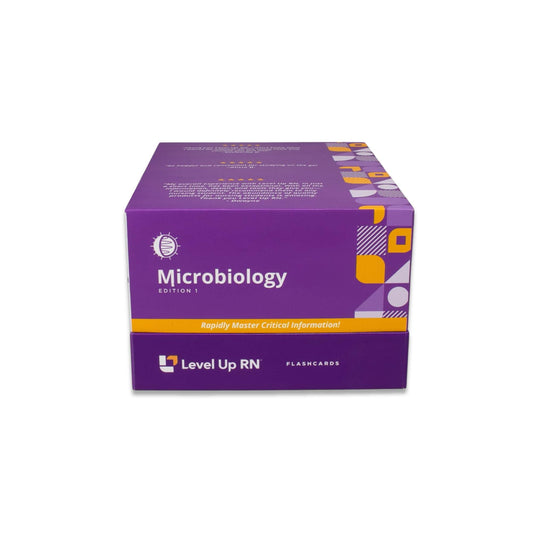Hi, I'm Cathy with Level Up RN. In this video, I'm going to continue my coverage of topics from our Level Up RN Microbiology flashcards. Specifically, I'll be going over some important terminology related to light and microscopes, as well as the different parts of a bright-field microscope. At the end of the video, I'm going to give you guys a quiz to test your understanding of some of the key facts I'll be covering. So definitely stay tuned for that. And if you have our Level Up RN Micro flashcards, go ahead and pull them out so you can follow along with me.
Let's first go over some important terminology related to light and microscopes. The first term I would be familiar with is refraction. This refers to the change in direction of a light wave when it enters a new medium or material. So for example, when light passes through the air into glass, this changes the direction of the light wave. The refraction index of a medium or material is the light-bending ability of that medium.
Next, let's talk about a lens, which is a curved surface that collects all the light that hits it and focuses it at one point called a focal point to produce an image. Magnification is the ability of the lens to enlarge an image, so a lens with a magnification of 10x will create an image that is 10 times larger than in real life. Resolution is the ability to distinguish two separate points or objects in an image. So resolution is going to be better with a microscope that uses shorter wavelengths, such as an electron microscope, and with a microscope that uses a lens with a higher numerical aperture. So numerical aperture refers to how well a lens is able to gather light. So the higher the numerical aperture, the better the resolution.
Another term to be familiar with as it pertains to microscopes is contrast. Contrast refers to the ability to distinguish different parts of a specimen. So certain microscopes, such as a phase-contrast microscope, are going to provide better contrast than a bright-field microscope. However, we can use dyes and stains when using a bright-field microscope to help improve contrast. When using a bright-field microscope, which is the most common type of microscope, when light rays pass through the air between the lens and the specimen, the air will scatter the light rays, which decreases resolution. This is because there is a big difference between the refractive index of air versus the refractive index of glass. To solve this problem, we can use an oil-immersion lens with a drop of oil between the lens and the specimen. Because oil and glass have a similar refractive index, this allows more light to pass through the specimen, which improves resolution.
Let's now review how a bright-field microscope works and the key parts of a bright-field microscope. As I mentioned before, it's the most common type of microscope and the one you'll be using in your lab. A bright-field microscope uses two or more lenses to produce a dark image on a bright background. Most organisms will need to be stained ahead of time in order to improve contrast and visibility. And of note, the staining process will kill the microorganisms in the specimen.
Parts of a bright-field microscope include the illuminator, which is the light source. Light from the illuminator passes through the condenser lens, which focuses the light on the specimen. The diaphragm is used to adjust the amount of light that hits the specimen, and the stage is the platform that holds the specimen slide. The objective lens is the lens closest to the specimen. The magnification of the objective lens can vary between 4x and 100x. And the nosepiece is used to rotate between the different objective lenses. The ocular lens is located in the eyepiece, and it typically provides a magnification of 10x. Some microscopes are monocular, meaning they only have one eyepiece, and others are binocular, meaning they have two eyepieces.
The total magnification of a microscope is the magnification of the objective lens times the magnification of the ocular lens. So if a microscope has an objective lens with a magnification of 40x and an ocular lens with a magnification of 10x, you would take 40 times 10, and that would give you 400. So the microscope would have a total magnification of 400x.
And lastly, to bring the image in focus, the coarse-focusing knob would be used to raise or lower the stage very quickly. So it would be used for large-scale movements, whereas the fine-focusing knob would be used to raise or lower the stage very slowly. So it would be used for small-scale movements.
All right, it's quiz time, and I have four questions for you. Number one. Blank refers to the change in direction of light waves as they enter a new medium of different density. The answer is refraction. Number two. What is the benefit of using an oil-immersion lens? The answer is it decreases light refraction and allows more light to pass through the microscope slide. Number three. Which lens on a bright-field microscope is closest to the specimen? The answer is the objective lens. Number four. If the objective lens magnification on a microscope is 20x and the ocular lens magnification is 10x, what is the total magnification of the microscope? The answer is 200x. So 20 times 10 equals 200.
All right, that's it for this video. I hope it was helpful. Take care and good luck with studying.
[BLOOPERS]
Resolution refers to the [inaudible] as opposed to the fine-coarse [inaudible].


